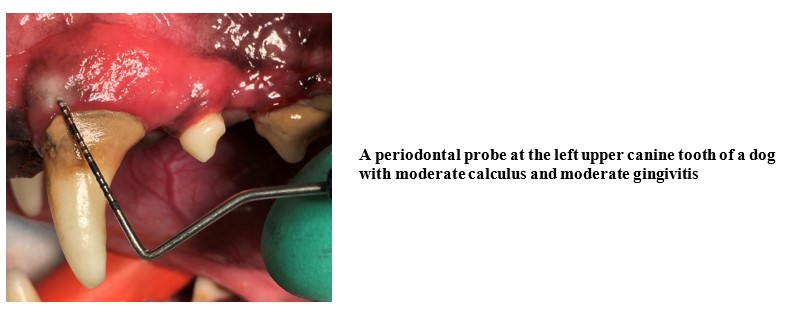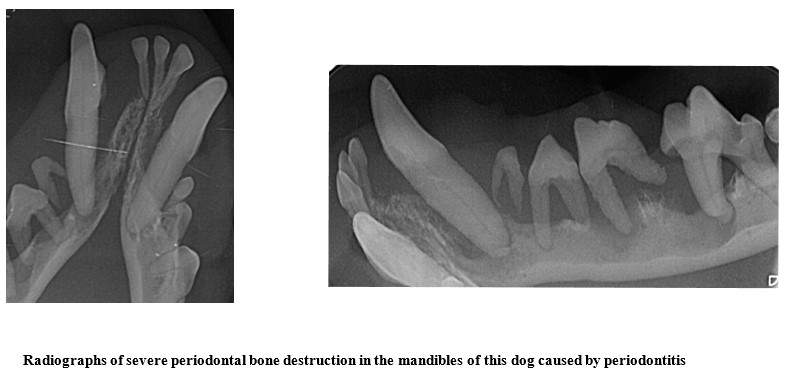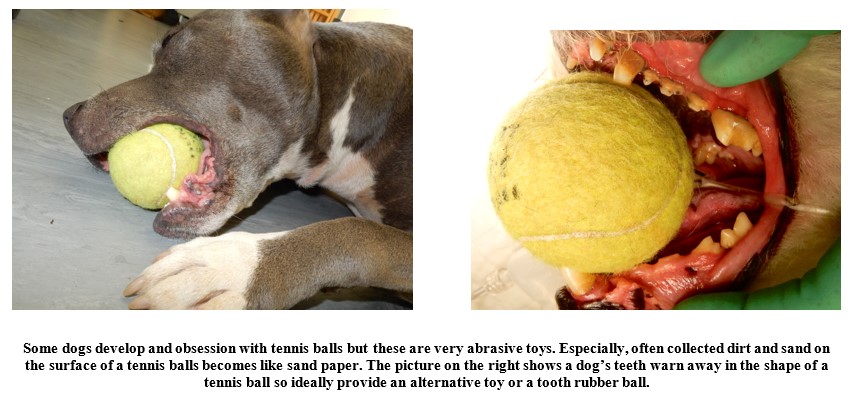
Periodontal disease is divided into the less severe early stage gingivitis, and periodontitis once more attachment (of the tooth to the surrounding tissue) loss had occurred.
To distinguish between gingivitis and periodontitis during a conscious clinical examination is difficult and, in most cases, impossible. The main reason is that clinically evident gingivitis could be gingivitis only or in fact merely a sign of periodontitis. Probing and especially radiography (x-ray imaging) with the patient under general anaesthesia confirms the situation and is crucial to formulate the an effective treatment plan.
Without ongoing dental home care, even after effective professional cleaning (ultrasonic scaling and possibly polishing) under general anaesthesia, periodontal disease would almost inevitably reoccur. It is important to realise that professional cleaning should therefore only be considered an important part of the treatment of periodontal disease.

Brushing
All dogs will benefit from daily tooth brushing but some individuals effectively remove plaque through normal earring and chewing behaviour. The benefit of brushing might not be that easy to demonstrate in these animals.
Smaller dog breeds and especially toy breeds have been shown to be more susceptable to periodontal disease, and brushing in these animals are very important.
It is important to use animal specific tooth pastes but it is the mechanical action of brushing that removes plaque and the role of the paste is really to make the process more pleasant and thus better tolerated for longer.
Specially designed animal tooth brushes are available and helps to make the procedure more easy for the one handling the brush and, in this way, possibly better. Any human soft or medium-soft tooth brush could achieve the same result. Like in our own case, remember to replace tooth brushes frequently.
A recent study found that brushing once daily is the best with every other day brushing a close second. Brushing once a week did no better than not brushing at all! So ideally, aim to brush daily but a minimum of three times a week for it to make a difference.
Unlike in humans, that aim to remove food remnants from our tooth surfaces (prevent caries or tooth decay), it is handy to remember that brushing before food is not important in dogs and cats. Reward for allowing brushing by having their beloved food could therefore be a great method to consider. A chew or favourite toy after brushing uses the same positive reinforcement method to teach tooth pets to allow brushing.
To brush cats’ teeth is more challenging but with gentle technique, it is possible. To brush cats’ cheek teeth just push the lips and corner of the mouth out of the way to reach them rather than attempting to fit the brush into the mouth, under the cheek.
Normal dry complete diets are brittle and usually crumbles when chewed. Dogs on such dry food would often have premolar and molar teeth with the cusps of crowns cleave any calculus. Plaque remains on the crowns at the gum line (where it really matters). With specially formulated dental diets, the kibbles contains fibres that requires the tooth to cut trough them to break the kibble down to be swallowed. Hills T/D and Royal Canin’s Dental Diet are the two brands that have published data to support their claims. This is an effective additional tool in especially smaller dogs and cats.
Dogs and cats have primarily cutting teeth allowing these animals to cut off chunks of their prey that can be swallowed. Dental chews that allow teeth to penetrate attempt to simulate this action and such chews could be more effective to remove plaque Not all chews that claim effective plaque control is effective though. The Veterinary Oral Health Council (VOHC) is an independent organisation of academics and leading veterinary dental specialist. They evaluate such efficacy claims and reward products that have successfully proven its claims, the VOHC seal. The VOHC website describes the testing process and list products that have been awarded this seal. This is therefore a good reference site to evaluate manufacturers' claims: Remain very sceptical of efficacy claims unsubstantiated in this way.
If any snake oil added to drinking water of food was as effective as some claims, we would all add it to our breakfast cereal because periodontal disease is very much a human problem too!

Periodontal surgery
Periodontal surgery is a surgical treatment option that is available to save strategically important teeth, affected by periodontitis. To consider this treatment, oral hygiene and dental home care should be of a very high standard. The primary aim of periodontal surgery is to reduce or ideally eliminate periodontal pockets (bone destruction associated with periodontitis).
Some of the treatment options to consider would be open debridement, with or without bone grafting. Teeth that are suitable for this treatment would be considered on a case-by-case basis. This advanced treatment should really only be considered in specially selected cases with owners able to provide very effective oral hygiene.
